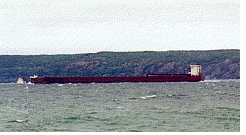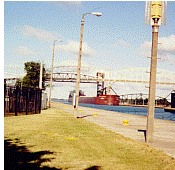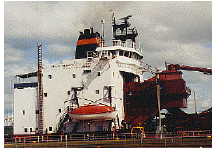|
How the Locks Work
at
Sault Ste Marie MI
The locks connect Lake Superior
to the remaining Great Lakes
|
The locks are necessary as the only connection between Lake
Superior and the rest of the Great Lakes is the St. Mary's Canal. The
St. Mary's Canal, at the Lake Superior end, has a 21 foot waterfall
between Lake Superior and the lower lakes.
The locks permit deep draft ships to travel around the St.
Mary's Waterfall and manage the 21 foot difference in water levels.
Lake Superior is 21 feet higher than the other Great Lakes.
The locks raise and lower the vessels easily because the water
will seek its own level as they open the gates. The locks move the
water by gravity. |
|
As a boat locks in from Lake Superior, the gates at each end of
the locks are closed and a valve is open to let the Lake Superior
water already in the lock flow out to the lower water level of the St
Mary's Canal and Lakes Huron and Michigan. When the water has dropped
to the lower level, the lock gate at the south end is opened and the
boat proceeds out of the locks into the St Mary's Canal. The north
gate remains closed, holding back the waters of Lake
Superior.

|

|
PAUL R. TREGURTHA inching its way into the Poe Lock.
It took about 1 hour for the ship to enter the lock, and
prepare to drop the 21' to the lower Great Lakes. |
The Paul R. Tregurtha is 1013' 6" overall, 105' wide
and just barely fits in the Poe Lock that is 1200' long and
110' wide. |

|

|
She is the longest vessel on the Great Lakes and has
held this honor since she was built in 1981. |
The Paul R. Tregurtha within the Poe Lock and starting
to lock down. |

|

|
The Paul R. Tregurtha down the 21 feet to the level of
the lower Great Lakes and moving out of the lock. She is
carrying iron ore (taconite pellets). Her cargo capacity is
68,000 tons. |
When a boat locks in from the St. Mary's Canal at the lower
level of Lakes Huron and Michigan, the gates at both ends are closed
and the filling valve at the north end is opened to permit the Lake
Superior water to flow into the lock. When the water in the lock has
risen to that of Lake Superior, the lock gate at the north end is
opened and the boat locks out into Lake Superior.
Before the locks were built, early pioneers portaged their
canoes, small boats and then larger boats around the waterfall and
refloated them in Lake Superior. Early shipwreck history has repeated
mentions of small boats wrecked at Sault Ste. Marie.
In 1797, the Northwest Fur Company built a lock 38 feet long on
the Canadian side of the river for small boats. This lock remained in
use until it was destroyed in the War of 1812. Freight and boats were
again portaged around the rapids until another lock was built.
Congress passed an act in 1852 for the construction of 2 new
locks which were completed in 1855.
Within a few years, commerce through the canal had grown to
national importance, and the need for new locks became clear. The
funds required exceeded the state's capabilities, and thus, in 1881
the locks were transferred to the United States government under the
jurisdiction of the U.S. Army Corps of Engineers. The Corps has
operated the locks, toll free, since that time. |
|
Check out what is happening right now at the locks with the Soo Locks Live Web Cam
Maybe one of the 1000'
freighters is locking through.
Back to the Soo
Locks
Exploring
Sault Ste. Marie, Michigan
E-Mail for
more Information
Back to Recreation
Adventures in the Upper Peninsula
Upper Peninsula Towns
and Cities
The Upper Peninsula
Traveler
Back to Exploring the North Home
Page
Photos: Vivian Wood
|








